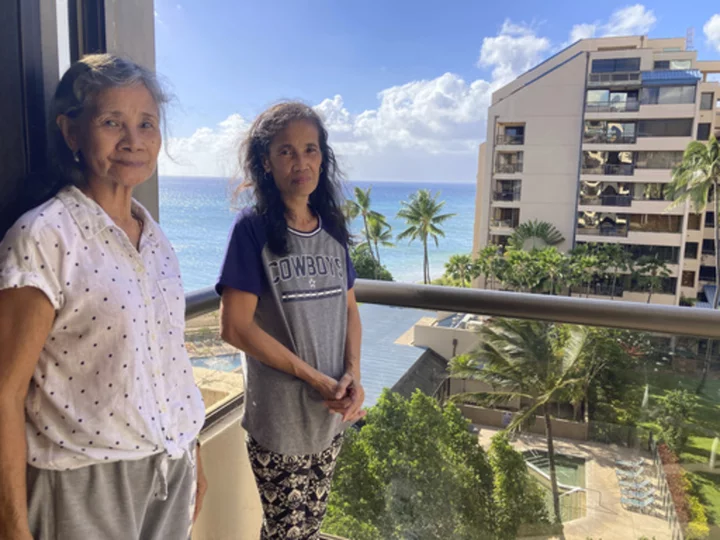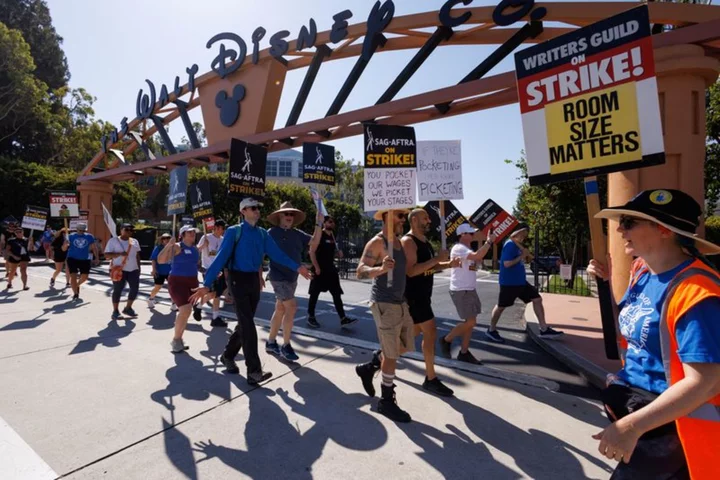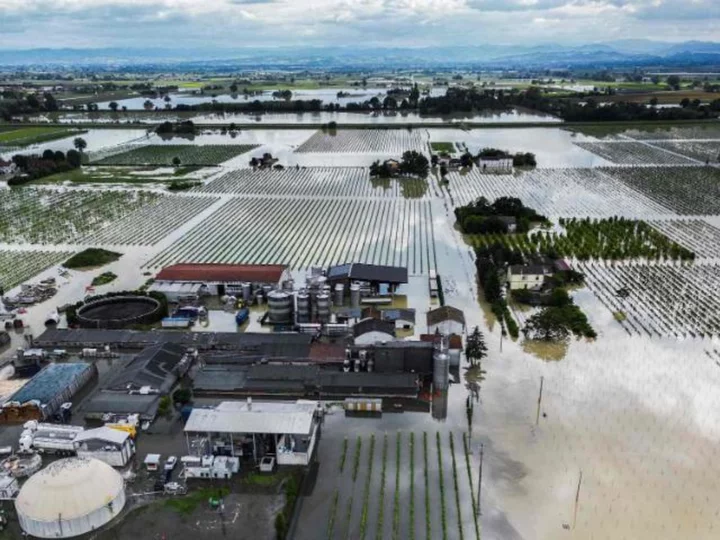LAHAINA, Hawaii (AP) — Ambulance and fire truck sirens wailed outside as Elsie Rosales stripped linens from king-sized mattresses at a beachfront resort in Lahaina.
She tried to focus on the work, but was beset by dread: Had a wildfire taken the home she scrimped to buy on a housekeeper’s wages?
It had. And now Rosales, like many other Filipino housekeepers used to cleaning hotels, is living in one with her family, a poignant example of how the deadliest U.S. wildfire in more than a century has afflicted Maui’s heavily Filipino population.
“All our hard work burned,” Rosales told The Associated Press in an interview conducted in Ilocano, her native language. “There is nothing left.”
The disaster has prompted fears about what will become of Lahaina’s community and character as it rebuilds.
Many are concerned residents like Rosales won’t be able to afford to live in Lahaina after the community is rebuilt, and that affluent outsiders seeking a home in the oceanfront town will price them out.
Will Filipinos, Native Hawaiians and others who have been the backbone of the tourism industry for so long be able to remain here? Will they want to?
Filipinos began arriving in Hawaii more than a century ago to labor on sugarcane and pineapple plantations. As their descendants and successive generations of immigrants have settled, they have become deeply ingrained in the community’s culture.
Today, they account for the second-largest ethnic group on Maui, with nearly 48,000 island residents tracing their roots to the Philippines, 5,000 of them in Lahaina, which was about 40% of the town’s population before the fire. The U.S. Census Bureau estimates about one-fourth of Hawaii’s 1.4 million people are of Filipino descent.
Many of them work in hotels, health care and food service. Filipinos account for about 70% of the members of UNITE HERE Local 5, the union representing workers in those industries, union President Gemma Weinstein said. She is Filipino and a former Honolulu hotel housekeeper.
“If it wasn’t for the Filipinos having two or three jobs, a lot of the businesses here, including the hotels, would have a hard time operating,” said Rick Nava, a community advocate and Filipino immigrant who lost his own home in the fire.
A month after the Aug. 8 disaster killed at least 115 people, nearly 6,000 people were staying at two dozen hotels serving as temporary shelters around Maui.
A number are hotel housekeepers like Rosales, 61, who is staying in a two-bedroom suite with her two sisters, her son, his wife and three grandchildren at the Sands of Kahana resort. Rosales' 72-year-old sister, Evangeline Balintona, works there as a housekeeper.
In the sisters' suite, there is an artificial plant in the corner of the living room, between a window overlooking the ocean and the flat-screen TV, that Balintona has dusted countless times. When she makes the bed, she does it the way she always has done for work, with layers of sheets and a comforter tucked neat and tight under a heavy mattress.
"I know every corner of this room,” Balintona said.
She is thinking about returning to Ilocos Norte, the family's hometown in the Philippines. She hopes her son there has saved enough from the monthly remittances she sent over the years to support her if she returns with nothing.
Tourists have been told to avoid Lahaina for now, and many hotels are housing federal aid workers. Balintona and others worry about the futures of their jobs.
Rosales, who said she did not know anyone who died in the fire, immigrated to Hawaii in 1999. After years of renting and saving for a down payment, she bought a five-bedroom home on Lahaina's Aulike Street in 2014 for $490,000. Her mother and siblings owned homes nearby. Those also are gone now.
She continues to work at another resort a few miles from where the sisters are staying. On her days off, she sorts out insurance paperwork, including trying to itemize belongings lost in the fire.
Rosales recalled the night of the fire when she and her co-workers — almost all from the Philippines — were forced to remain in the hotel because roads were blocked. She didn't learn the fate of her home until the next morning, when her youngest son called.
“Mom, no more house,” he told her.
“No, anak ko!” she shrieked, using an Ilocano term meaning “my child.”
Around her, other housekeepers sobbed as they received similar calls.
The Rev. Efren Tomas, pastor of Christ the King Church in Kahului, worries about the mental health of survivors. He has been counseling groups of Filipinos staying in hotels, even celebrating Mass in a hotel reception room.
“For Filipinos, it’s very hard for them to go into one-on-one counseling,” he said. “They want to gather in a group. I think they get strength from each other.”
Many longtime Lahaina residents, including Native Hawaiians, told the AP they worry that whatever is built from the ashes of Lahaina won’t include Filipinos and other ethnic groups who made it the working class community it was.
“The new Lahaina should be the old Lahaina,” said Alicia Kalepa, who lives in a Hawaiian homestead where most of the houses survived the fire. “Mixed culture.”
Gilbert Keith-Agaran, a state senator from Maui who is stepping down to focus on litigation work involving the fires, said he won’t be surprised if many Filipinos leave for places such as Las Vegas, an affordable destination for Hawaii residents who no longer can afford to live here.
“I think it’s hard to take the Filipinos out of the fabric of our community,” said Keith-Agaran, whose father came from Ilocos Norte in 1946 for plantation work. “We intermarried a lot with others who are here.”
Melen Magbual Agcolicol was 13 when she arrived on Maui from the Philippines more than four decades ago with her family. Since then, she has become a community advocate and is president of Binhi at Ani, “Seed and Harvest,” which operates Maui’s only Filipino community center.
Her group unveiled a fund called Tulong for Lahaina, or Help for Lahaina. The idea is to provide grants to Filipinos who lost homes, shops or loved ones.
“The starting over is so difficult. How are you going to start over? Number one, you don’t have a job,” she said. “Number two, your sanity. Your sanity is not normal until you think that you can accept what happened to you.”
Rosales’ three sons don’t want her to sell her property, but she is finding it difficult to think about the future. She can’t sleep or eat, can’t stop crying.
Residents have not been allowed to return to the burned areas. Rosales wants to go back. She wants to comb through the rubble of her American dream, hoping to find a piece of her jewelry collection, a gold bracelet or a watch, luxuries she would never have been able to afford in the Philippines.
“Even if it’s black,” she said, “I want to take it as a remembrance.”
She touched the delicate gold hoops dangling from her ears. She put them on the morning she left her house to go to work.
___
Associated Press writer Bobby Caina Calvan contributed.









